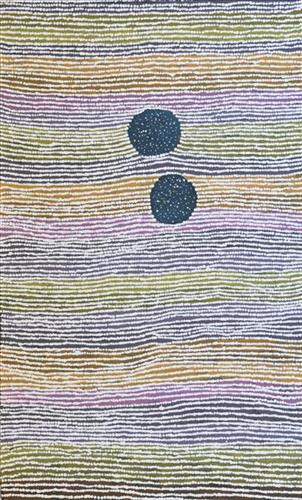111582325331
Nyinyiri
“This is the rockhole and sandhills. ‘you do my country’ she (Mulyatingki) told me. She been born in that area. They used to drink that water [from the rockhole]. I ask Nancy (Mulyatingki’s sister) about it. They have a rockhole there, like a soak. They drink from it. I want to go there one day and take this mob (Dianne’s children).”
Nyinyiri is a small soak yulparirra (south) of Juntu-juntu (Canning Stock Route Well 30). This area is where Dianne’s mother (Mulyatingki Marney) – was born. It is Mulyatingki’s ngurra (home Country, camp), and forms part of the area which she knew intimately and travelled extensively with her family in her youth. Dianne knows Nyinyiri through her mother’s stories and paintings.
During the pujiman (traditional, desert dwelling) period, Martu would traverse very large distances annually in small family groups, moving seasonally from water source to water source, and hunting and gathering bush tucker as they went. At this time knowledge of water sources was critical for survival, and today Martu Country is still defined in terms of the location and type of water. Each of the hundreds of claypans, rockholes, waterholes, soaks and springs found in the Martu desert homelands is known by name, location, quality and seasonal availability through real life experience and the recounting of Jukurrpa (Dreaming) narratives.
Soaks, or soakwaters, derive their name from the manner in which their waters generally seep into the sand from below stores, sometimes as part of an ephemeral river or creek. Soaks were an especially important source of water during the pujiman era, being the most dependable water source in times of drought. Water was obtained from soaks by scooping away the sand with a piti (timber bowls used for carrying food and water) until clear water gathered at the base of the hole, sometimes at a depth of several metres.




